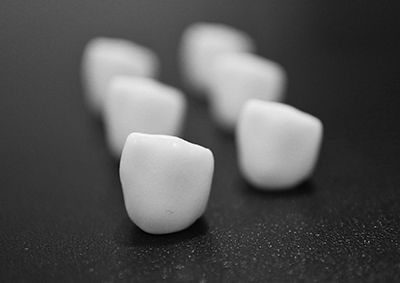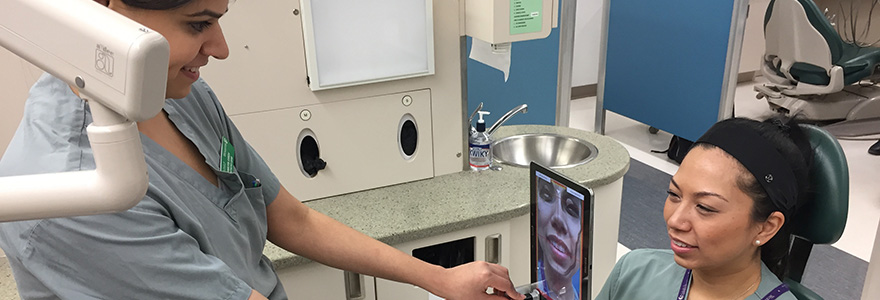A new frontier in dentistry
By Crystal Mackay MA’05
Never before has our reliance on technology and the advantages that the digital world affords us been so apparent. As the pandemic forced many of our lives to exist on the other side of a computer screen, digital technology was thrust into the spotlight. While digital dentistry has been rapidly advancing field, the COVID-19 pandemic highlighted its advantages – speed, precision and accessibility – in an entirely new way.
“In light of the COVID-19 pandemic, we know that dentistry is a high-risk profession because of close-contact exposure to patients and the potential for aerosol-generating procedures,” said Dr. Les Kalman, Assistant Professor at Schulich Dentistry. “Digital dentistry allows us to do things more efficiently, and in a way which translates to less time in the mouth.”
Digital dentistry includes a whole gamut of technologies, from generating 3D scans of the mouth and jaw-bone through what’s known as cone-beam computed tomography (CBCT), to computer-aided-design and manufacture (CAD/CAM) of crowns, implant components and dentures, to the creation of customized orthodontic applicances, and emerging technologies like augmented reality for treatment planning and the introduction of virtual appointments and tele-dentistry.
As digital dentistry continues to become more and more mainstream, its advantages are becoming more apparent, and education leaders at Schulich Dentistry are looking for ways to further integrate it into the curriculum.
“We are looking at how this can make our clinic more efficient and how we can bring learning to a different level where we are preparing clinicians for this new frontier in dentistry,” said Dr. Gildo Santos, Associate Dean of Undergraduate Dental Education.
Learners already have access to scanners that produce high quality restorations for patients who need implants, abutments and crowns, and plans are underway to increase access and exposure to CAD/CAM technology.
Dr. Santos is looking forward to the installation of intraoral cameras for the main dental clinic at the School. These cameras will allow student dentists to visualize their patients’ teeth and gums on a big screen in real-time right at chair-side. This is beneficial for patients to be able to see what the student dentist sees and fully understand the treatment plan.
It also provides instructors the ability to guide learning in real-time, and gives students access to equipment that they will likely use in the future in their practice.
“This is part of an ongoing initiative focused on digital dentistry in our curriculum,” said Dr. Santos. “The digital cameras provide a powerful communication tool for students. It allows them to communicate better with patients and paves the way for advances in digital dentistry.”
And these digital technologies aid in every aspect of dentistry and orthodontics. Digital scans of the dental arches are replacing traditional molds and casts of the teeth. Just this technology alone has huge advantages in terms of efficiency.
“You can take a digital impression for a full dental arch in four minutes, cutting the appointment time down in half compared to the analogue method,” said Dr. Santos. “Then if you account for the ease of translating that into the framework for a crowns or dentures, and the fact that you don’t need to store the cast in a physical space, it only makes sense to integrate it into our clinics.”
 These digital impressions can then be used to guide treatment planning and diagnosis and to 3D print surgical guides for implant dentistry, or to mill or 3D print custom crowns, implant components or dentures. In orthodontics, the technology can be used to create custom braces that are designed specifically for each patient’s teeth.
These digital impressions can then be used to guide treatment planning and diagnosis and to 3D print surgical guides for implant dentistry, or to mill or 3D print custom crowns, implant components or dentures. In orthodontics, the technology can be used to create custom braces that are designed specifically for each patient’s teeth.
Dr. Santos points out that this type of digital dentistry combined with virtual appointments and tele-dentistry will greatly improve access to care for patients in rural and remote communities. “If you have a chair-side scanner, with a push of a button you can send the digital impressions off to be printed, even if you don’t have immediate access to a dental laboratory,” he said.
Clear aligners, which have taken the orthodontic industry by storm, are another example of digital dentistry that is rapidly becoming the standard of practice. Using artificial intelligence, the company that developed clear aligners is able to incrementally improve its results with every new patient case.
Dr. Ali Tassi, Assistant Dean, Postgraduate Dental Education, and Acting Chair/Program Director in the Division of Graduate Orthodontics and Dentofacial Orthopaedics, says that surprisingly, this technology wasn’t invented by a dentist or orthodontist. Instead, it was a postgraduate business student who watched his orthodontist with the model made from a cast physically adjusting the teeth and resetting them, and saw it as an opportunity to digitize the process.
“Sometimes in dentistry we get stuck in doing things the way we’ve always done them,” said Dr. Tassi. This is why he feels it is so important to continue to expose learners in the program to these cutting-edge technologies.
“For many practising orthodontists in the community, digital dentistry has become really integrated into every part of their practice workflow, from remote consultations, to diagnosis and treatment planning, to designing and manufacturing custom appliances, to virtual monitoring,” he said.
CAD/CAM technology isn’t new. It was first introduced in the mid-1980s, but required a lot of effort on the part of the user and was very expensive with very limited advantages in terms of output.
Technology has improved and costs have come down, and Dr. Kalman explains that this is part of the reason why ongoing research and development in this area is so important.
As a clinician-researcher at Schulich Dentistry, Dr. Kalman, along with students in his lab, have been involved in research and development of digital technologies to add to the dentist’s toolkit including a virtual facebow called MaxAlign which functions as a digital replacement for the conventional facebow used to evaluate bite position. Students are aiding in the assessment of the technology in the clinic.
His lab is also working on applications for 3D metal printing for implant dentistry, and most recently developed a digital smile shade application that would allow dentists to use a digitizer to more accurately determine the shade for a tooth, soft tissues and dental materials.
“As we continue to develop this technology, it makes it more efficient, more user-friendly and more cost-effective and that will translate to increased accessibility for dentists and patients,” said Dr. Kalman.









